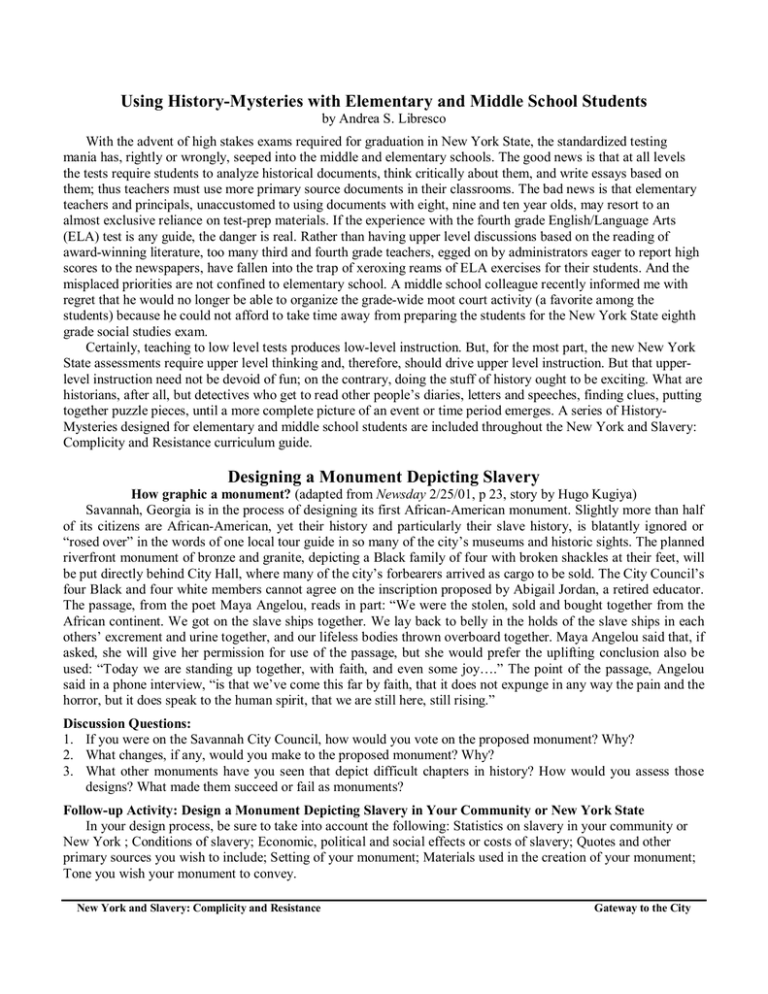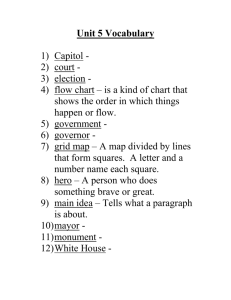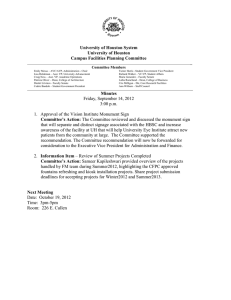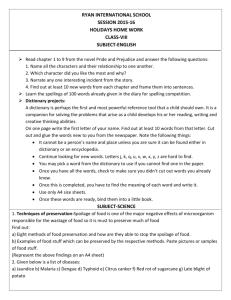Using History-Mysteries with Elementary and Middle School Students
advertisement

Using History-Mysteries with Elementary and Middle School Students by Andrea S. Libresco With the advent of high stakes exams required for graduation in New York State, the standardized testing mania has, rightly or wrongly, seeped into the middle and elementary schools. The good news is that at all levels the tests require students to analyze historical documents, think critically about them, and write essays based on them; thus teachers must use more primary source documents in their classrooms. The bad news is that elementary teachers and principals, unaccustomed to using documents with eight, nine and ten year olds, may resort to an almost exclusive reliance on test-prep materials. If the experience with the fourth grade English/Language Arts (ELA) test is any guide, the danger is real. Rather than having upper level discussions based on the reading of award-winning literature, too many third and fourth grade teachers, egged on by administrators eager to report high scores to the newspapers, have fallen into the trap of xeroxing reams of ELA exercises for their students. And the misplaced priorities are not confined to elementary school. A middle school colleague recently informed me with regret that he would no longer be able to organize the grade-wide moot court activity (a favorite among the students) because he could not afford to take time away from preparing the students for the New York State eighth grade social studies exam. Certainly, teaching to low level tests produces low-level instruction. But, for the most part, the new New York State assessments require upper level thinking and, therefore, should drive upper level instruction. But that upperlevel instruction need not be devoid of fun; on the contrary, doing the stuff of history ought to be exciting. What are historians, after all, but detectives who get to read other people’s diaries, letters and speeches, finding clues, putting together puzzle pieces, until a more complete picture of an event or time period emerges. A series of HistoryMysteries designed for elementary and middle school students are included throughout the New York and Slavery: Complicity and Resistance curriculum guide. Designing a Monument Depicting Slavery How graphic a monument? (adapted from Newsday 2/25/01, p 23, story by Hugo Kugiya) Savannah, Georgia is in the process of designing its first African-American monument. Slightly more than half of its citizens are African-American, yet their history and particularly their slave history, is blatantly ignored or “rosed over” in the words of one local tour guide in so many of the city’s museums and historic sights. The planned riverfront monument of bronze and granite, depicting a Black family of four with broken shackles at their feet, will be put directly behind City Hall, where many of the city’s forbearers arrived as cargo to be sold. The City Council’s four Black and four white members cannot agree on the inscription proposed by Abigail Jordan, a retired educator. The passage, from the poet Maya Angelou, reads in part: “We were the stolen, sold and bought together from the African continent. We got on the slave ships together. We lay back to belly in the holds of the slave ships in each others’ excrement and urine together, and our lifeless bodies thrown overboard together. Maya Angelou said that, if asked, she will give her permission for use of the passage, but she would prefer the uplifting conclusion also be used: “Today we are standing up together, with faith, and even some joy….” The point of the passage, Angelou said in a phone interview, “is that we’ve come this far by faith, that it does not expunge in any way the pain and the horror, but it does speak to the human spirit, that we are still here, still rising.” Discussion Questions: 1. If you were on the Savannah City Council, how would you vote on the proposed monument? Why? 2. What changes, if any, would you make to the proposed monument? Why? 3. What other monuments have you seen that depict difficult chapters in history? How would you assess those designs? What made them succeed or fail as monuments? Follow-up Activity: Design a Monument Depicting Slavery in Your Community or New York State In your design process, be sure to take into account the following: Statistics on slavery in your community or New York ; Conditions of slavery; Economic, political and social effects or costs of slavery; Quotes and other primary sources you wish to include; Setting of your monument; Materials used in the creation of your monument; Tone you wish your monument to convey. New York and Slavery: Complicity and Resistance Gateway to the City New York and Slavery: Complicity and Resistance Gateway to the City





